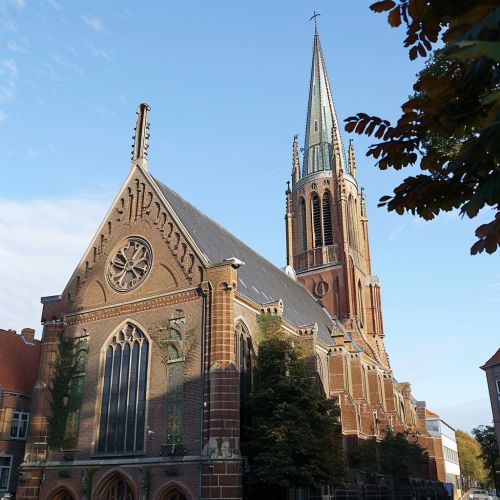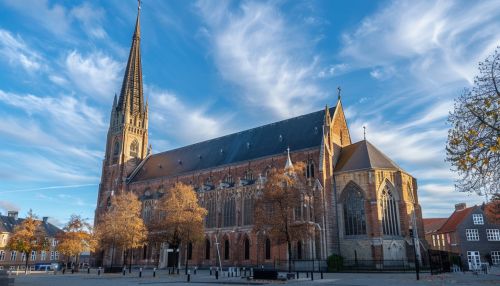Aarhus Cathedral: Difference between revisions
(Created page with "== History == Aarhus Cathedral, also known as the Cathedral of St. Clement, is located in Aarhus, Denmark. The cathedral is dedicated to St. Clement, the patron saint of sailors. The construction of the cathedral began in the late 12th century and continued over several centuries, resulting in a blend of architectural styles. The initial construction was in the Romanesque style, but it was later expanded and modified in the Gothic style during the 15th century. The cat...") |
No edit summary |
||
| Line 13: | Line 13: | ||
The exterior of the cathedral features a combination of brick and limestone, typical of Danish church architecture. The west facade is adorned with a large rose window and three portals, each with intricate carvings and sculptures. The central portal is the largest and most ornate, depicting scenes from the life of St. Clement. | The exterior of the cathedral features a combination of brick and limestone, typical of Danish church architecture. The west facade is adorned with a large rose window and three portals, each with intricate carvings and sculptures. The central portal is the largest and most ornate, depicting scenes from the life of St. Clement. | ||
[[Image:Detail-91391.jpg|thumb|center|Exterior view of Aarhus Cathedral with its tall spire and intricate facade.|class=only_on_mobile]] | |||
[[Image:Detail-91392.jpg|thumb|center|Exterior view of Aarhus Cathedral with its tall spire and intricate facade.|class=only_on_desktop]] | |||
=== Interior === | === Interior === | ||
Latest revision as of 12:01, 21 June 2024
History
Aarhus Cathedral, also known as the Cathedral of St. Clement, is located in Aarhus, Denmark. The cathedral is dedicated to St. Clement, the patron saint of sailors. The construction of the cathedral began in the late 12th century and continued over several centuries, resulting in a blend of architectural styles. The initial construction was in the Romanesque style, but it was later expanded and modified in the Gothic style during the 15th century.
The cathedral has undergone several restorations and renovations throughout its history. The most significant restoration took place in the 19th century, led by the Danish architect Vilhelm Theodor Walther. This restoration aimed to preserve the historical integrity of the cathedral while making necessary repairs and updates.
Architecture
Aarhus Cathedral is the longest and tallest church in Denmark, measuring 93 meters in length and 96 meters in height. The cathedral's architecture is a mix of Romanesque and Gothic styles, reflecting the different periods of its construction and renovation.
Exterior
The exterior of the cathedral features a combination of brick and limestone, typical of Danish church architecture. The west facade is adorned with a large rose window and three portals, each with intricate carvings and sculptures. The central portal is the largest and most ornate, depicting scenes from the life of St. Clement.


Interior
The interior of Aarhus Cathedral is equally impressive, with a nave flanked by two aisles, a transept, and a choir. The nave is characterized by its high vaulted ceilings and large clerestory windows, which allow natural light to flood the space. The choir is separated from the nave by a rood screen, a common feature in medieval churches.
The cathedral houses several notable artworks, including a 15th-century altarpiece by the German artist Bernt Notke and a series of frescoes depicting scenes from the Bible. The frescoes, which date back to the 14th and 15th centuries, are considered some of the finest examples of medieval art in Denmark.
Organ
The organ of Aarhus Cathedral is one of the largest and most renowned in Denmark. The current organ was built by the Danish organ builder Marcussen & Søn in 1928, replacing an earlier instrument. The organ has 89 stops and over 6,000 pipes, making it one of the most versatile and powerful organs in the country.
The organ is used for both liturgical purposes and concert performances. It has been played by many renowned organists and has been featured in numerous recordings. The sound of the organ is characterized by its rich, full tone and its ability to produce a wide range of dynamics and colors.
Bells
Aarhus Cathedral has a total of 10 bells, the largest of which is known as the "Stormklokken" or "Storm Bell." The bells are housed in the cathedral's tower, which was completed in the 15th century. The bells are used to mark the hours and to call the faithful to worship.
The "Stormklokken" is particularly notable for its deep, resonant tone. It was cast in 1497 and weighs over 4,000 kilograms. The bell is rung on special occasions, such as religious festivals and national holidays.
Crypt
The crypt of Aarhus Cathedral is one of the oldest parts of the building, dating back to the original Romanesque structure. The crypt contains several tombs and burial sites, including the remains of several bishops and other notable figures from the history of Aarhus.
The crypt is also home to a small chapel dedicated to St. Clement. The chapel is adorned with frescoes and other artworks, making it a popular destination for visitors to the cathedral.
Stained Glass Windows
The stained glass windows of Aarhus Cathedral are among its most striking features. The windows date from various periods, with some of the oldest dating back to the 14th century. The windows depict scenes from the Bible, as well as images of saints and other religious figures.
One of the most notable windows is the "Tree of Jesse" window, which depicts the genealogy of Christ. The window is located in the choir and is considered one of the finest examples of medieval stained glass in Denmark.
